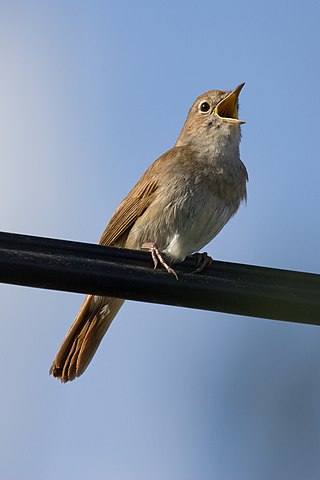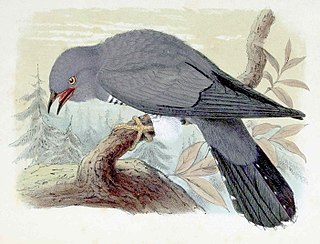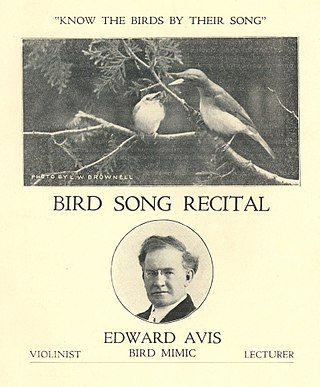
The common nightingale, rufous nightingale or simply nightingale, is a small passerine bird which is best known for its powerful and beautiful song. It was formerly classed as a member of the thrush family Turdidae, but is now more generally considered to be an Old World flycatcher, Muscicapidae. It belongs to a group of more terrestrial species, often called chats.

The song thrush is a thrush that breeds across the West Palearctic. It has brown upper-parts and black-spotted cream or buff underparts and has three recognised subspecies. Its distinctive song, which has repeated musical phrases, has frequently been referred to in poetry.

The wood thrush is a North American passerine bird in the family Turdidae and is the only species placed in the genus Hylocichla. It is closely related to other thrushes such as the American robin and is widely distributed across North America, wintering in Central America and southern Mexico. The wood thrush is the official bird of the District of Columbia.

The eyebrowed thrush is a member of the thrush family Turdidae. It breeds in dense coniferous forest and taiga eastwards from Siberia and Mongolia to Japan. It is strongly migratory, wintering south to China and Southeast Asia. It is a rare vagrant to western Europe.

Sálim Moizuddin Abdul Ali was an Indian ornithologist and naturalist. Sometimes referred to as the "Birdman of India", Salim Ali was the first Indian to conduct systematic bird surveys across India and wrote several bird books that popularized ornithology in India. He became a key figure behind the Bombay Natural History Society after 1947 and used his personal influence to garner government support for the organisation, create the Bharatpur bird sanctuary and prevent the destruction of what is now the Silent Valley National Park.

The rail-babbler or Malaysian rail-babbler is a brown and pied rail-like ground-living bird. It is the only species in the genus Eupetes and family Eupetidae. It lives on the floor of primary forests in the Malay Peninsula and Sumatra, as well as Borneo. It is distantly related to African crow-like birds. Its population has greatly decreased because much of the lowland primary forest has been cut, and secondary forests usually have too dense a bottom vegetation or do not offer enough shade to be favourable for the species. However, it is locally still common in logged forest or on hill-forest on slopes, and probably not in immediate danger of extinction. The species is poorly known and rarely seen, in no small part due to its shyness.

The ʻōmaʻo, also called the Hawaiian thrush, is an endemic species of robin-like bird found only on the island of Hawaii. ʻŌmaʻo are closely related to the other endemic thrushes of the Hawaiian Islands, the kāmaʻo, the olomaʻo, and the puaiohi. ʻŌmaʻo are found primarily in rainforests in the eastern and southeastern regions of the Big Island. Population estimates approximate 170,000 birds, making it the most common of the Hawaiian thrushes. It appears to have a stable population, but because the entire population exists on a small range and is endemic to a single island, it is considered vulnerable.

Charles Kellogg was an American vaudeville performer who imitated bird songs, and later a campaigner for the protection of the redwood forests of California. He was born on a ranch in Susanville, California and grew up in the 1870s observing the animals and birds of the forests and learning outdoor skills. He constructed a mobile home, called the "Travel Log", out of a redwood tree and drove it around the country to raise awareness of the plight of the California forests. Its maximum speed was 18 mph. The Travel Log itself is currently on display in the Visitor Center at Humboldt Redwoods State Park.

The blue whistling thrush is a bird in the Old World flycatchers family Muscicapidae that is found in the mountains of Central Asia, South Asia, China and Southeast Asia. It is known for its loud human-like whistling song at dawn and dusk. The widely distributed populations show variations in size and plumage with several of them considered as subspecies. Like others in the genus, they feed on the ground, often along streams and in damp places foraging for snails, crabs, fruits and insects.

The Taiwan whistling thrush, also known as the Formosan whistling thrush, is a species of bird in the family Muscicapidae. It is endemic to Taiwan.

The Malayan whistling thrush or Malaysian whistling-thrush is a species of bird in the family Muscicapidae. It is endemic to the Malay Peninsula. Due primarily to habitat loss, its population is thought to be in decline.

Fontenelle Forest is a 1,500-acre (6 km2) forest, located in Bellevue, Nebraska. Its visitor features include hiking trails, a nature center, children's camps, a gift shop, and picnic facilities. The forest is listed as a National Natural Landmark and a National Historic District. The forest includes hardwood deciduous forest, extensive floodplain, loess hills, and marshlands.

Antonine Barada, alternatively spelled Antoine Barada, was an American folk hero in the state of Nebraska; son of an Omaha mother, he was also called Mo shi-no pazhi in the tribal language. While Barada was a historic man, contemporary accounts of his prodigious strength helped establish him as a regional legend, in the mold of Paul Bunyan and Febold Feboldson. Barada's exploits have been counted as fakelore by historians.
"Boll Weevil" is a traditional blues song, also known by similar titles such as "Boweavil" or "Boll Weevil Blues". Many songs about the boll weevil were recorded by blues musicians during the 1920s through the 1940s. However, a rendition by Lead Belly recorded in 1934 by folklorist Alan Lomax led to it becoming well-known. A 1961 adaptation by Brook Benton became a pop hit, reaching number two on the Billboard Hot 100. Fats Domino's "Bo Weevil" is a different song.

Paul Austin Johnsgard was an ornithologist, artist and emeritus professor at the University of Nebraska. His works include nearly fifty books including several monographs, principally about the waterfowl and cranes.

Insects have appeared in music from Rimsky-Korsakov's "Flight of the Bumblebee" to such popular songs as "Blue-tailed Fly" and the folk song La Cucaracha which is about a cockroach. Insect groups mentioned include bees, ants, flies and the various singing insects such as cicadas, crickets, and beetles, while other songs refer to bugs in general.

Birdsong has played a role in Western classical music since at least the 14th century, when composers such as Jean Vaillant quoted birdsong in some of their compositions. Among the birds whose song is most often used in music are the nightingale and the cuckoo.

Joe Belmont was the stage name of Joseph Walter Fulton who was a whistling performer and baritone in the United States who came to be known as "The Human Bird". He was one of the most popular recording artists in the years leading to 1900 and sang as a baritone and whistled for the Columbia Quartet along with Albert Campbell, Jim Reynard and Joe Majors. His top-selling records included "Beautiful Birds, Sing On", "Tell Me, Pretty Maiden".

Edward Avis was the stage name of Martin E. Sullivan, an American violinist and stage performer known for his imitations of birdsongs. He performed on the stage in New England and was referred to by the press as "The Bird Man".



















